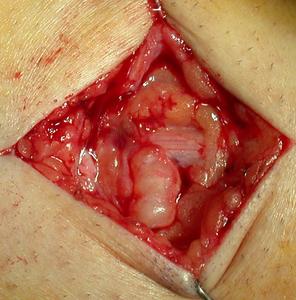The main differential diagnosis is a benign tumor arising from the Schwann
cell of the nerve, a Schwannoma or neurilemmoma. Other nerve tumours
(neurofibroma) should be considered. If this was not attached to the nerve a
sub-fascial lipoma or angio-lipoma would be high on the differential diagnosis
list.
A Schwannoma is the most likely cause of a fatty appearing nodule attached
to a nerve.
Other considerations would include other nerve cell tumours, sub-fascial
lipomas and various sarcomas.
The nodule is deep to the deep fascia.
A sub-fascial lipoma is a possibility, on clinical examination these often
stand up more when the underlying muscles are contracted. It should not be
attached to the nerve though.
A sebaceous cyst is attached to the skin, the contents are not fatty but
cheese like. Sebaceous cysts are normally found superficial to the deep
fascia.
A Schwannoma or neurilemmoma is the most likely diagnosis. These tumours
arise from the fatty (myelin) producing Schwann cells surrounding the axons in
the nerve, thus they look fatty and are attached to the nerve.
The possibility of a tumour attached to a nerve should be considered in
evaluating a patient with a 'lump'. If the patient is not advised about the
possibility of nerve damage and subsequently complains of loss of
the nerve function or painful neuralgia, they will be much aggrieved.
